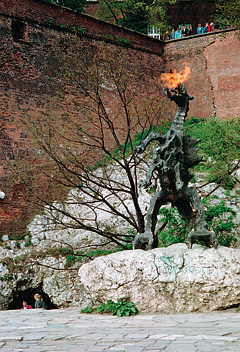|
Even more complicated preparations were made in 1787 in Jaskinia Ciemna
before the visit of the last Polish king, Stanisław August Poniatowski.
Comfortable paths and stairs with railings were built on the slope leading
to the cave, and the silt at the bottom was paved with planks. The cave
became lighted up brightly, and a special triumphal arch was erected inside
it. A brass band added splendour to the visit, and the special exhibition
of dripstones was on display in the neighbouring castle. From that time
organized trips lead by trained guides have taken place in the caves of
Ojców region. At that time torches or special lanterns were used to light
up the caves. In the middle of the 19th century the first permanent gas
illumination was installed in Jaskinia Wierzchowska Górna, while electric
lighting appeared as first in Jaskinia Ciemna at the beginning of the
20th century. In the 20’s and 30’s of the 20th century the most popular
Polish show cave was Jaskinia Kryształowa. It was made available to tourists
with a great expenditure of money, and in 1933 a special guidebook to
the cave, titled Przewodnik po jaskiniach w Krzywczu (The Guidebook to
the Caves in Krzywcze) was published. Currently, although the number of
known caves in Poland amounts to 3,600, only nine of them are show caves.
One is situated in the Tatra Mountains (Jaskinia MroĽna), one in the ¦więtokrzyskie
Mountains (Jaskinia Raj), five on the Krakowsko-Częstochowska Upland (Smocza
Jama in Cracow, Jaskinia Łokietka, Jaskinia Ciemna, Jaskinia Wierzchowska
Górna, and Jaskinia Nietoperzowa), one in the Sudety Mountains (Jaskinia
NiedĽwiedzia) and one in Polish Lowlands (Jaskinia w Mechowie). Smocza
Jama is the most often-visited cave, with 200-250 thousands of visitors
annually. The next four (Jaskinia Łokietka, Jaskinia NiedĽwiedzia, Jaskinia
Raj, and Jaskinia MroĽna) have 100-200 thousands of visitors annually.
The last four are less popular. Most of them are open to tourists from
May to October (Jaskinia Nietoperzowa from March to November). There are
small exhibitions of dripstones, and archaeological and paleontological
findings from the caves in Nietoperzowa, NiedĽwiedzia, Raj and Wierzchowska
Górna.
 |
|
Then monument of the dragon
in front of Dragon's Den in Kraków
|
Jaskinia Ciemna Situated in the Ojcowski National Park, about
20 km north-west of the centre of Cracow. Mentioned in 1691, very important
archaeological site, findings from Palaeolithic Age (dated on ca. 120,000
years). Entrance at the elevation of 410 m above sea level. Spacious chamber
about 80 m long (up to 20 m wide) with a corridor. Length - 186 m.
Jaskinia Łokietka Situated in the Ojcowski National Park, about
20 km north-west of the centre of Cracow (entrance situated close to a
motorway). Mentioned in 1691. Entrance at the elevation of 453 m above
sea level. Two big chambers with corridors. Length - 320 m.
Jaskinia MroĽna Situated in the Western Tatra Mountains, in the
Ko¶cieliska Valley. Discovered in 1934, made available to tourists in
1959. Entrances at the elevation of ca. 1,100 m above sea level. Horizontal
system of corridors and chambers, going straight through a mountain ridge;
dripstones. Length - 530 m.
Jaskinia Nietoperzowa Situated in the upper Będkowska Valley, in
the village of Jerzmanowice, about 18 km north-west of the centre of Cracow.
Mentioned in 1841, rich Palaeolithic, Neolithic and Middle Age findings.
Made available to tourists in 1994. A film scene of riding horses was
shot inside the cave. Entrance at the elevation of 447 m above sea level.
Spacious system of corridors and chambers. Length - 320 m.
Jaskinia NiedĽwiedzia Situated in Kletno, in the massif of ¦nieżnik
mount (the Eastern Sudety Mountains), about 15 km south-east of the town
of Kłodzko. Discovered during marble exploitation works in 1966. Entrances
at the elevation of ca. 800 m above sea level. Three-level system of corridors
and chambers with elaborate dripstones. Length - 2.23 km, only the upper
level available to visitors.
Jaskinia Raj
Situated inside Malik hill, in the vicinity of the small town of Chęciny
(the ¦więtokrzyskie Mountains), about 10 km south-west of the centre of
Kielce). Discovered in 1964, made available to visitors in 1972, findings
from Palaeolithic Age. Entrances at the elevation of ca. 250 m above sea
level. Horizontal system of corridors and chambers with elaborate and
diversified dripstones. Length - 240 m.
Smocza Jama in Cracow (Dragon's Den) Situated in the centre
of Cracow, at the foot of Wawel hill under the Royal Castle towers. This
is the reason why Smocza Jama is the most known cave in Poland. A very
popular legend says that a fierce dragon (monument at the entrance) inhabited
the cave. A clever shoemaker managed to kill the beast offering it a sheep
filled with sulphur. Mentioned as early as 1190. In 1544 its entrance
was pictured in form of a wood engraving. Entrance at the elevation of
205 m above sea level. Several spacious chambers. Entrance from the Royal
Castle.
Jaskinia w Mechowie Situated in the village of Mechowo, about 9
km west of the resort Puck. Mentioned in 1829. Entrances at the elevation
of ca. 60 m above sea level. Unique cave formed in Pleistocene sandstones,
horizontal corridor with rock columns near the entrance. Length - 61 m.
Jaskinia Wierzchowska Górna Situated in the Kluczwody Valley, about
15 km north-west of the centre of Cracow. Mentioned in 1853, findings
from Neolithic Age. Entrances at the elevation of 390 m above sea level.
Horizontal system of corridors and chambers. Length - 975 m.
Additionally, a number of caves in Poland is made available to visitors,
e.g. by building access paths and installing facilities (e.g. ladders,
railings), but there are not lighted up and there is no entrance fee.
In the Tatra Mountains there are five such caves (Mylna, Raptawicka, Obłazkowa,
Smocza Jama in Kraków Gorge, and cave Dziura). The most known caves in
the other regions are (among the others) Jaskinia Malinowska in the Beskidy
Mountains and Jaskinia Radochowska in the Sudety Mountains. 
|


